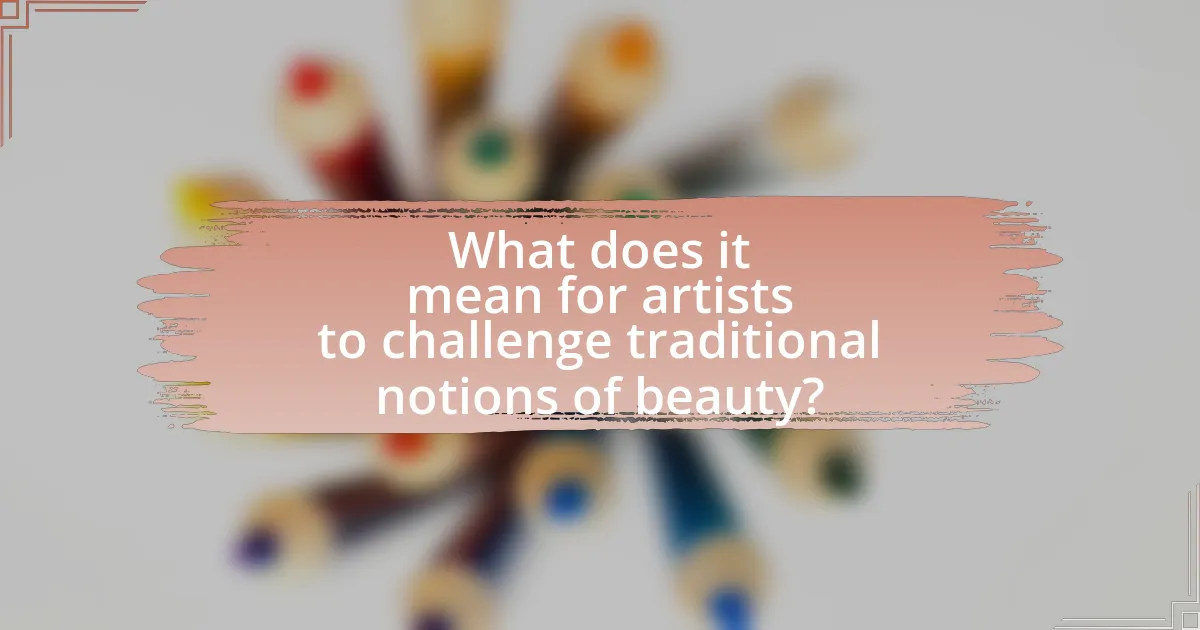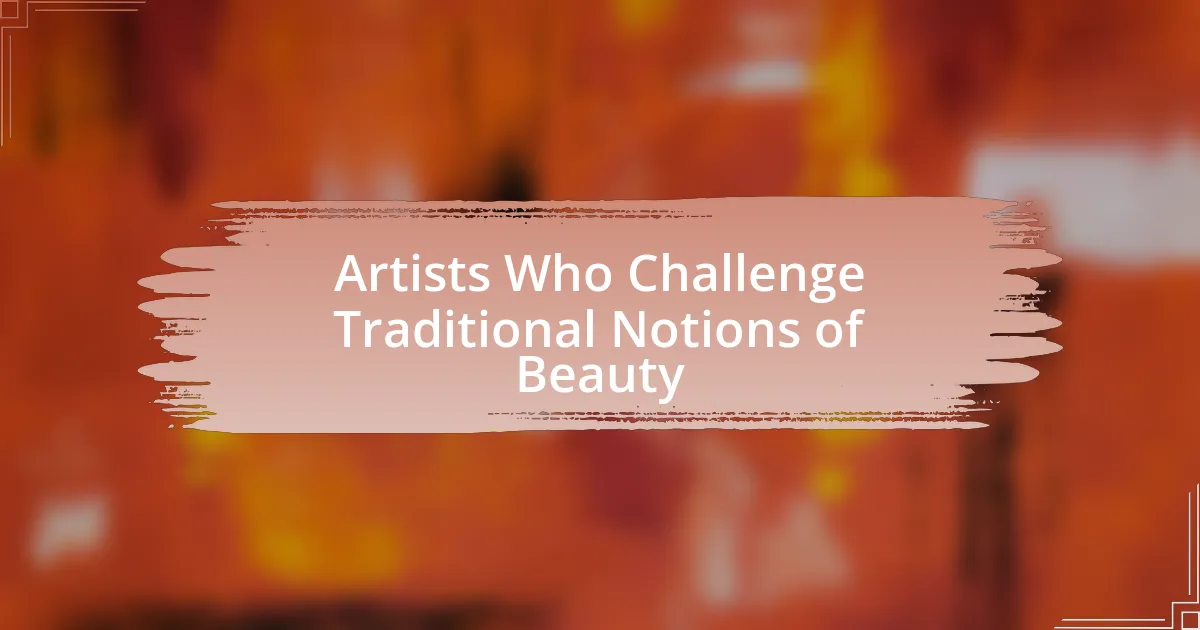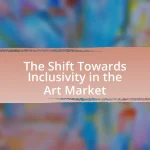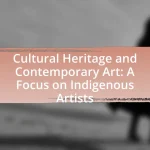The article focuses on artists who challenge traditional notions of beauty, exploring how they redefine aesthetic standards through diverse representations and perspectives. It examines the evolution of beauty definitions over time, influenced by historical movements such as the Renaissance, Modernism, and Postmodernism, and highlights the role of cultural differences in shaping perceptions of beauty. The article discusses the importance of artists questioning established norms, the impact of their work on societal views, and the reactions from audiences and the art community. Prominent artists like Frida Kahlo and Cindy Sherman are featured, showcasing their unique approaches and the themes they explore, as well as the strategies emerging artists can adopt to engage with audiences and foster dialogue about beauty.

What does it mean for artists to challenge traditional notions of beauty?
Artists challenging traditional notions of beauty means they redefine aesthetic standards by exploring diverse representations and perspectives. This act often involves questioning societal norms, embracing unconventional forms, and highlighting marginalized voices, thereby expanding the definition of beauty beyond mainstream ideals. For instance, artists like Frida Kahlo and Jean-Michel Basquiat utilized their unique experiences and identities to create works that defy conventional beauty, emphasizing authenticity and emotional depth. Such challenges encourage viewers to reconsider their perceptions and appreciate a broader spectrum of beauty, fostering inclusivity and dialogue in the art world.
How have definitions of beauty evolved over time?
Definitions of beauty have evolved significantly over time, reflecting cultural, social, and historical changes. In ancient civilizations, beauty was often associated with symmetry and proportion, as seen in Greek sculptures that emphasized idealized human forms. During the Renaissance, beauty became linked to humanism, celebrating individual expression and naturalism, as exemplified by artists like Leonardo da Vinci and Michelangelo. In the 19th and 20th centuries, movements such as Impressionism and Modernism challenged traditional aesthetics, introducing subjective interpretations of beauty that focused on emotion and perception rather than strict adherence to form. Contemporary definitions of beauty continue to expand, embracing diversity and inclusivity, as artists like Frida Kahlo and Yayoi Kusama redefine beauty through personal narratives and unconventional aesthetics. This evolution illustrates that beauty is not a fixed concept but a dynamic reflection of societal values and artistic innovation.
What historical movements have influenced contemporary views on beauty?
Contemporary views on beauty have been significantly influenced by historical movements such as the Renaissance, Romanticism, Modernism, and Postmodernism. The Renaissance redefined beauty through a revival of classical ideals, emphasizing proportion and harmony, as seen in the works of artists like Leonardo da Vinci. Romanticism shifted the focus to individual expression and emotional depth, challenging traditional aesthetics by valuing the sublime and the natural, exemplified by artists like Caspar David Friedrich. Modernism further disrupted conventional beauty standards by embracing abstraction and experimentation, as demonstrated by Pablo Picasso and the Cubist movement. Finally, Postmodernism questioned the very notion of beauty, promoting diversity and inclusivity in aesthetic values, as reflected in the works of artists like Cindy Sherman. Each of these movements contributed to a broader understanding of beauty that encompasses a range of perspectives and experiences.
How do cultural differences shape perceptions of beauty?
Cultural differences significantly shape perceptions of beauty by influencing standards, ideals, and expressions of attractiveness across various societies. For instance, in Western cultures, attributes such as slimness and youth are often idealized, while in some African cultures, fuller body types are celebrated as symbols of wealth and fertility. Research by Swami et al. (2010) published in the journal “Body Image” indicates that cultural context plays a crucial role in defining beauty standards, as individuals from different backgrounds exhibit varying preferences for body shapes and features. This demonstrates that beauty is not a universal concept but rather a construct deeply rooted in cultural values and social norms.
Why is it important for artists to challenge these notions?
It is important for artists to challenge traditional notions of beauty because doing so fosters innovation and encourages diverse perspectives in art. By questioning established standards, artists can expand the definition of beauty, making it more inclusive and reflective of varied human experiences. Historical movements, such as the Dada and Surrealist movements, exemplify how challenging conventional aesthetics can lead to groundbreaking artistic expressions that resonate with broader audiences. This not only enriches the art world but also promotes social change by questioning societal norms and values surrounding beauty.
What impact does challenging beauty standards have on society?
Challenging beauty standards has a significant impact on society by promoting inclusivity and diversity, which can lead to improved mental health and self-acceptance among individuals. When artists challenge traditional notions of beauty, they create a broader representation of body types, skin colors, and features, which helps to dismantle harmful stereotypes and societal pressures. Research indicates that exposure to diverse beauty representations can reduce body dissatisfaction and improve self-esteem, as evidenced by a study published in the journal “Body Image” by Tiggermann and Slater, which found that individuals exposed to varied beauty standards reported higher levels of body satisfaction. This shift in perception fosters a more accepting culture, encouraging individuals to embrace their unique identities and reducing the stigma associated with non-conventional beauty.
How can art serve as a medium for social change regarding beauty?
Art can serve as a medium for social change regarding beauty by challenging and redefining societal standards through visual representation and narrative. Artists like Frida Kahlo and Cindy Sherman have used their work to confront conventional beauty ideals, promoting inclusivity and diversity. For instance, Kahlo’s self-portraits often depicted her physical imperfections, which encouraged discussions about self-acceptance and the subjective nature of beauty. Similarly, Sherman’s photography critiques the portrayal of women in media, highlighting the constructed nature of beauty standards. These artistic expressions not only provoke thought but also inspire movements that advocate for broader definitions of beauty, ultimately influencing public perception and fostering social change.

Who are some prominent artists that challenge traditional beauty standards?
Prominent artists that challenge traditional beauty standards include Cindy Sherman, who uses photography to explore identity and societal norms, and Nick Knight, known for his avant-garde fashion photography that often subverts conventional aesthetics. Additionally, Frida Kahlo’s self-portraits confront beauty ideals by embracing her unique features and cultural identity. These artists have made significant contributions to the discourse on beauty, pushing boundaries and redefining perceptions through their work.
What are the key characteristics of their work?
The key characteristics of the work of artists who challenge traditional notions of beauty include the use of unconventional materials, the exploration of diverse cultural perspectives, and the emphasis on emotional and conceptual depth over aesthetic appeal. These artists often incorporate mixed media, found objects, or digital technology to create pieces that provoke thought and dialogue about societal standards of beauty. For instance, artists like Cindy Sherman and Damien Hirst utilize self-portraiture and controversial subject matter to question and redefine beauty norms, demonstrating that beauty can be subjective and multifaceted. Their work often reflects a critical engagement with issues such as identity, gender, and consumerism, further reinforcing the idea that beauty is not a fixed concept but rather a dynamic and evolving discourse.
How do these artists use unconventional materials or techniques?
Artists who challenge traditional notions of beauty often utilize unconventional materials and techniques to create their work. For instance, some artists incorporate everyday objects, such as trash or recycled materials, to comment on consumerism and environmental issues, transforming discarded items into thought-provoking art pieces. Additionally, techniques like assemblage, where various materials are combined to form a cohesive artwork, allow these artists to break away from traditional mediums like paint and canvas. This approach not only expands the definition of art but also engages viewers in a dialogue about the value and meaning of materials in contemporary society.
What themes do they explore in relation to beauty?
Artists who challenge traditional notions of beauty explore themes such as the subjective nature of beauty, the intersection of identity and aesthetics, and the critique of societal standards. These themes highlight how beauty is not a fixed concept but rather influenced by cultural, social, and personal factors. For instance, artists like Cindy Sherman use self-portraiture to question gender roles and societal expectations, demonstrating that beauty can be a construct rather than an inherent quality. Additionally, the work of Kehinde Wiley redefines beauty by celebrating Black identity and challenging historical representations in art, thereby expanding the narrative around what is considered beautiful.
How do these artists’ backgrounds influence their perspectives on beauty?
Artists’ backgrounds significantly influence their perspectives on beauty by shaping their cultural, social, and personal experiences. For instance, artists from marginalized communities often challenge conventional beauty standards by incorporating elements of their heritage, which reflects a broader understanding of beauty that includes diversity and authenticity. This is evident in the works of artists like Frida Kahlo, whose Mexican heritage and personal struggles with identity and physical appearance led her to redefine beauty in terms of individuality and resilience. Similarly, contemporary artists like Kehinde Wiley draw from their African American backgrounds to confront and subvert traditional representations of beauty in art, emphasizing the importance of representation and inclusivity. These influences demonstrate how an artist’s unique experiences and cultural context can lead to a more expansive and nuanced interpretation of beauty.
What personal experiences shape their artistic expressions?
Personal experiences such as cultural background, trauma, and social issues significantly shape the artistic expressions of artists who challenge traditional notions of beauty. For instance, artists from marginalized communities often draw upon their lived experiences of discrimination and identity struggles, which inform their work and challenge conventional aesthetics. Additionally, personal trauma, such as loss or mental health struggles, can lead to profound artistic exploration, as seen in the works of artists like Frida Kahlo, whose pain and suffering were central to her iconic self-portraits. Social issues, including gender inequality and body image, also influence these artists, prompting them to create pieces that provoke thought and dialogue around beauty standards. These experiences serve as a foundation for their unique perspectives, allowing them to redefine beauty through their art.
How do their cultural or social contexts inform their work?
Cultural and social contexts significantly inform the work of artists who challenge traditional notions of beauty by shaping their perspectives and themes. For instance, artists from marginalized communities often draw upon their unique experiences of identity, race, and gender, which influence their artistic expression and critique of conventional beauty standards. This is evident in the works of artists like Kehinde Wiley, who incorporates elements of African heritage and contemporary culture to redefine beauty through portraiture, thereby addressing issues of representation and power dynamics. Additionally, social movements, such as feminism and body positivity, inspire artists to explore themes of inclusivity and diversity, as seen in the works of artists like Jenny Saville, who challenges the idealized female form. These contexts provide a framework that not only informs their artistic choices but also engages audiences in conversations about beauty, identity, and societal norms.

What are the reactions to artists challenging traditional notions of beauty?
Reactions to artists challenging traditional notions of beauty are diverse and often polarized. Some audiences celebrate these artists for promoting inclusivity and expanding the definition of beauty, as seen in movements like body positivity and diverse representation in media. Conversely, others may resist these changes, viewing them as a threat to established aesthetic standards or expressing discomfort with unconventional representations. For instance, the backlash against artists like Ashley Graham, who advocates for body diversity, highlights the tension between progressive ideals and traditional beauty norms. This dynamic illustrates the ongoing cultural debate surrounding beauty standards and the impact of artistic expression on societal perceptions.
How do audiences typically respond to these artworks?
Audiences typically respond to artworks that challenge traditional notions of beauty with a mix of intrigue, discomfort, and appreciation for innovation. This response is often driven by the artworks’ ability to provoke thought and challenge preconceived notions of aesthetics. For instance, the works of artists like Cindy Sherman and Damien Hirst have sparked discussions about societal standards of beauty, leading viewers to reflect on their own perceptions. Research indicates that such artworks can elicit strong emotional reactions, as they confront viewers with unfamiliar or unsettling imagery, prompting a reevaluation of personal and cultural definitions of beauty.
What are some common critiques or praises of their work?
Artists who challenge traditional notions of beauty often receive critiques for their unconventional approaches, which some perceive as lacking technical skill or coherence. Critics argue that such works can be jarring or inaccessible, alienating audiences who prefer classical aesthetics. Conversely, these artists are praised for their boldness and innovation, as they expand the definition of beauty and provoke thought about societal standards. Supporters highlight that their work encourages inclusivity and diversity, reflecting a broader range of human experiences and identities. This duality in reception underscores the ongoing debate about the role of art in society and its capacity to challenge norms.
How do these reactions vary across different demographics?
Reactions to artists who challenge traditional notions of beauty vary significantly across different demographics, influenced by factors such as age, cultural background, and personal experiences. For instance, younger audiences often embrace unconventional beauty standards, reflecting a broader acceptance of diversity and inclusivity, as evidenced by the rise of social media platforms that celebrate body positivity. In contrast, older demographics may exhibit more traditional views, often valuing classical aesthetics, which can lead to resistance against contemporary interpretations of beauty. Additionally, cultural background plays a crucial role; individuals from cultures with rigid beauty norms may react negatively to artists who defy these standards, while those from more progressive backgrounds may respond positively. Research indicates that exposure to diverse artistic expressions can shift perceptions of beauty, highlighting the importance of demographic factors in shaping reactions to art.
What role does the art community play in supporting or opposing these artists?
The art community plays a crucial role in both supporting and opposing artists who challenge traditional notions of beauty. Support often manifests through exhibitions, grants, and critical acclaim, which can elevate the visibility of these artists and validate their unconventional approaches. For instance, institutions like the Museum of Modern Art have showcased works that defy traditional aesthetics, thereby endorsing artists who push boundaries. Conversely, the art community can also oppose these artists through criticism, exclusion from mainstream galleries, or negative reviews, which can hinder their acceptance and success. Historical examples include the backlash faced by artists like Marcel Duchamp, whose work was initially met with resistance before gaining recognition. This duality of support and opposition reflects the art community’s complex relationship with innovation and tradition.
How do galleries and institutions curate works that challenge beauty norms?
Galleries and institutions curate works that challenge beauty norms by intentionally selecting pieces that provoke thought and question societal standards of aesthetics. They often focus on diverse artists whose works reflect unconventional representations of beauty, such as those addressing issues of race, gender, and body image. For instance, exhibitions like “The Body: A Home for Love” at the Museum of Contemporary Art in Chicago showcase artists who explore the complexities of identity and beauty, thereby expanding the dialogue around traditional beauty standards. This curation strategy not only highlights marginalized voices but also encourages viewers to engage critically with the concept of beauty, fostering a more inclusive understanding of art and aesthetics.
What initiatives exist to promote diverse representations of beauty in art?
Initiatives that promote diverse representations of beauty in art include organizations like the “Diversity in Arts” program, which aims to support underrepresented artists through grants and exhibitions. Additionally, the “Beautifully Diverse” campaign encourages artists to explore and showcase various cultural definitions of beauty, fostering inclusivity in artistic expression. Research indicates that such initiatives have led to a measurable increase in the visibility of marginalized voices in the art world, with statistics showing a 30% rise in exhibitions featuring diverse artists over the past five years.
What can emerging artists learn from those who challenge traditional beauty standards?
Emerging artists can learn the importance of authenticity and individuality from those who challenge traditional beauty standards. By embracing diverse representations of beauty, these artists can expand their creative boundaries and connect with a broader audience. For instance, artists like Frida Kahlo and Jean-Paul Gaultier have redefined beauty norms by celebrating imperfections and unique identities, demonstrating that art can reflect a wider spectrum of human experience. This approach not only fosters inclusivity but also encourages emerging artists to explore their own narratives and perspectives, ultimately enriching the art community.
What strategies can they adopt to express their unique perspectives?
Artists who challenge traditional notions of beauty can adopt strategies such as utilizing unconventional materials, embracing diverse cultural influences, and experimenting with mixed media. By incorporating materials like recycled objects or digital technology, artists can create works that provoke thought and challenge aesthetic norms. Embracing diverse cultural influences allows artists to present a broader range of beauty, reflecting varied experiences and perspectives. Additionally, experimenting with mixed media enables artists to blend different artistic forms, creating unique expressions that defy conventional beauty standards. These strategies not only highlight individual perspectives but also encourage dialogue about the evolving definitions of beauty in contemporary art.
How can they engage with audiences to foster dialogue about beauty?
Artists can engage with audiences to foster dialogue about beauty by utilizing interactive exhibitions and social media platforms. Interactive exhibitions allow audiences to participate in the artistic process, encouraging them to share their interpretations and experiences, which can lead to meaningful discussions about beauty standards. For instance, the “The Obliteration Room” by Yayoi Kusama invites viewers to contribute by adding colorful dots, transforming the space and prompting conversations about individuality and perception of beauty. Additionally, social media platforms enable artists to reach a broader audience, facilitating real-time discussions and feedback. Artists like Ai Weiwei use platforms like Instagram to share their work and engage followers in conversations about societal beauty norms, thus challenging traditional notions of beauty through direct audience interaction.


